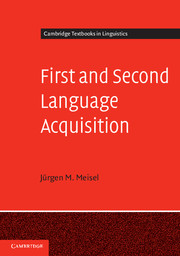Book contents
- Frontmatter
- Contents
- List of figures
- List of tables
- Preface
- List of abbreviations
- 1 The quest for the LAD
- 2 First language development: Universal Grammar as the centrepiece of the human language making capacity
- 3 Obvious (observable) similarities and differences between first and second language acquisition: Developmental sequences
- 4 The initial state and beyond
- 5 Developing grammatical knowledge: Parameter setting and inductive learning
- 6 Neural maturation and age: Opening and closing windows of opportunities
- 7 A (tentative) theory of language acquisition – L1, 2L1 and L2
- Glossary
- Notes
- References
- Index
7 - A (tentative) theory of language acquisition – L1, 2L1 and L2
Published online by Cambridge University Press: 05 June 2012
- Frontmatter
- Contents
- List of figures
- List of tables
- Preface
- List of abbreviations
- 1 The quest for the LAD
- 2 First language development: Universal Grammar as the centrepiece of the human language making capacity
- 3 Obvious (observable) similarities and differences between first and second language acquisition: Developmental sequences
- 4 The initial state and beyond
- 5 Developing grammatical knowledge: Parameter setting and inductive learning
- 6 Neural maturation and age: Opening and closing windows of opportunities
- 7 A (tentative) theory of language acquisition – L1, 2L1 and L2
- Glossary
- Notes
- References
- Index
Summary
Language acquisition is something that happens to children. It is not a task which they need to actively or consciously pursue, nor do they require special training, and they do not have to rely on coaching efforts from their caretakers. Mere exposure to their linguistic environment in interaction with their caretakers and peers suffices for them to acquire the language, and if they are exposed to more than one language, they are able to acquire each one without much apparent effort. The same cannot be said, however, about second language acquisition, as myriads of L2 learners who have failed to acquire native competence in the languages they were exposed to in either naturalistic or classroom settings can testify. These and similar observations suggest that children acquiring their languages from birth can rely on a Language Making Capacity which seems to become partially or totally inaccessible in the course of subsequent development. In fact, this consideration was the starting point of our discussion, defined in chapter 1 as a quest for the LAD. Our goal has been to discover essential properties of the LAD as they are revealed in first language development and to inquire about its fate as it is evidenced by child and adult second language acquisition. This enterprise aspires to a deeper and more comprehensive understanding of the human Language Making Capacity and ultimately of the language faculty.
- Type
- Chapter
- Information
- First and Second Language AcquisitionParallels and Differences, pp. 240 - 255Publisher: Cambridge University PressPrint publication year: 2011



